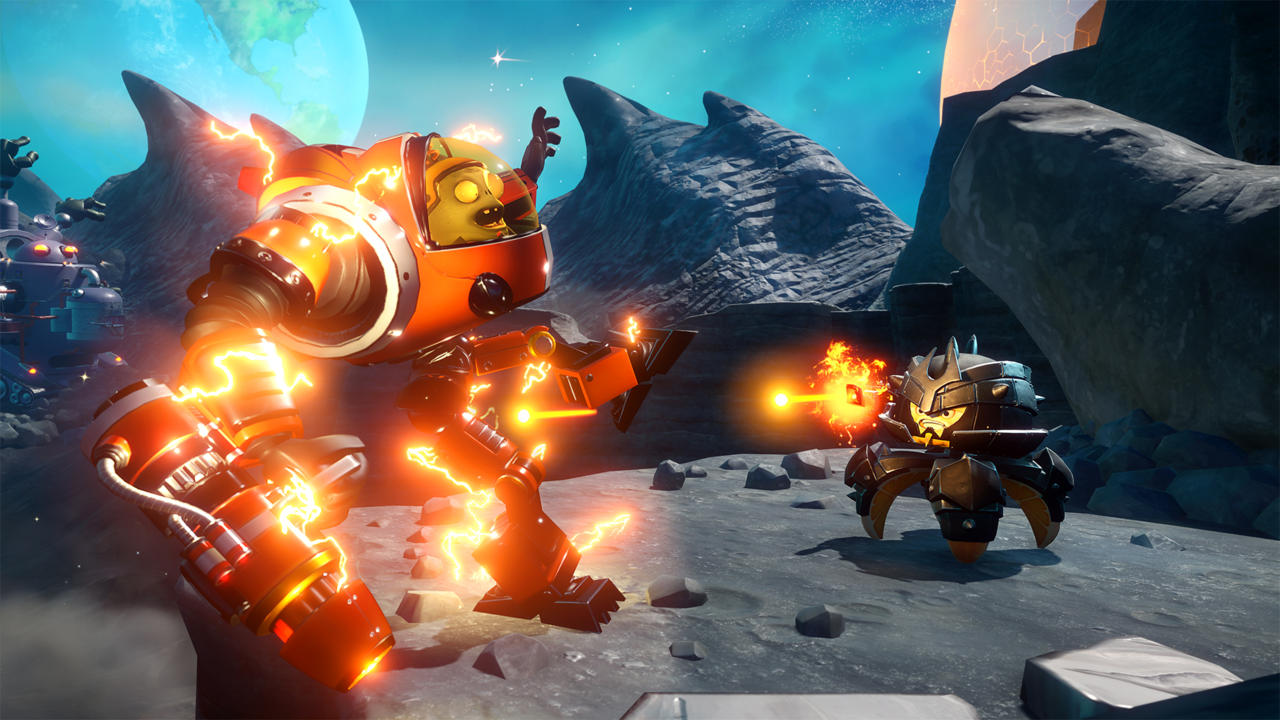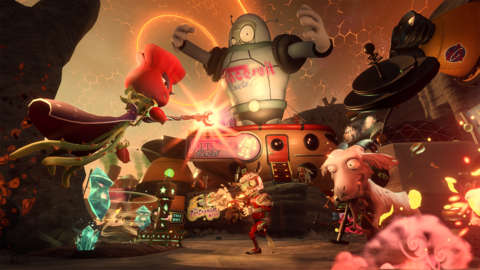I would attack the flying shrimp robot with my shoulder-mounted freeze ray, but a pirate just set me on fire and now I need to find a sunflower so I don't die before my team destroys the giant boot battering our castle gate.
In other words, Plants vs. Zombies: Garden Warfare 2 allies itself with light-hearted shooters like Splatoon rather than going for the gritty realism endemic to the genre. It doubles down on the established PvZ formula by maintaining its cheesy humor and silly costumes while adding new characters, updated modes, and additional solo content, plus a host of smaller improvements throughout. Most of this new material--particularly the extra characters--enhance the already enjoyable core experience, though the glacially-paced progression and repetitive single-player component dampen the fun.

The most noticeable difference for returning players is structural. The entire game now revolves around a playable hub area, with plants on one side, zombies on the other, and a contested area in between. There's also a decent amount of space around the edges littered with items to collect and secrets to uncover, including a few mini-games that can easily devour more time than you intended. The hub area's not only loaded with plenty of pleasant diversions, it also provides some context that allows the rest of the experience to feel a bit more meaningful. Both sides have distinct personalities, and while their oddball rivalry may be thin, it's enough to make the action make sense. It's also an excuse to bombard players with puns and dad jokes, and how could you not love that?
Beyond its narrative function, the hub world contains portals to all the various modes, including the cooperative Garden/Graveyard Ops horde mode, the revamped online multiplayer component, and the brand new single-player campaign. Unfortunately, "campaign" might be too generous a description. Most missions send you on a fetch quest in the hub world or throw you into a Garden Ops match with a finite number of enemy waves, with minimal XP and currency rewards when you succeed. Don't expect any exciting set pieces or decicated environments. Still, if you manage to grind through to the end of either team's story, you unlock a Blood Dragon-esque surprise that's pretty worthwhile. And if you're really desperate to avoid other humans, you can actually play every single mode with AI opponents and allies, both of whom are now far more intelligent compared to the original Garden Warfare.

While the single-player content is a bit of a bust, the new characters are anything but. The plants and zombies receive three new characters apiece, bringing the game's total to 14--an impressive number when you consider just how diverse they are both visually and mechanically. Every character operates in a totally different way--with different movement speeds, primary weapons, levels of health, special abilities, and more--and crazier still, there are 110 variants total. That's 110 different character forms, from scuba zombies to icy oranges, that function in inventive, mechanically distinct ways.
Each base character also embodies a specific archetype like tank or sniper, so the newcomers help to better balance both teams. Every character seems to have a counter-character; if you're getting dominated by someone, there's generally a combatant you can swap to in order to gain the upperhand. Because matchups are so crucial, strategy becomes a surprisingly important part of the experience, and it only works because the roster is so rich. When it comes to character diversity, Garden Warfare 2 outclasses other shooters in every way.
But this is where progression pacing becomes a problem. Characters level individually, so gaining experience and earning unlocks with one variant doesn't impact the others. This would be fine except leveling takes forever to payoff. You can boost one character to level five by playing online for roughly an hour. You know what that gets you? One passive character upgrade out what seems to be 24 possible, judging by the menu. Now imagine how long it would take to grind to level 50 (the current cap) with all 110 character variants. It's totally unnecessary and means you may not be able to swap to a strategically advantageous character without abandoning your upgraded character.
When it comes to character diversity, Garden Warfare 2 outclasses other shooters in every way.
This problem also extends to unlocks. The only way to acquire consumables, costumes, and new variants is to buy random sticker packs, but currency accrues just as slowly as XP. This severely limits how frequently you can buy new stuff, and when you do, there's no guarantee you'll even get what you're hoping for. With such an incredible wealth of content, the game could have given you a new character variant every 15 minutes and it still would have taken nearly 30 hours to earn them all. At its current pace, it will take hundreds of hours.
The good news is, anyone who played the original game can transfer all their characters over, and you can buy sticker packs and upgrade characters between rounds when playing online, which at least simplifies the process. It's also totally possible to enjoy Garden Warfare 2's robust online multiplayer with even basic, low-level characters. The borderline chaotic action emphasizes team play and rewards both offensive and defensive actions. I did find myself missing certain shooter mainstays like sprint, crouch, and basic melee options, but the shooting still feels tight and satisfying. Plus, the character's creative ability sets ended up driving most the moment-to-moment gameplay anyway, which led to plenty of glorious moments of chomping, bombing, and burning.

While you will of course find standard team deathmatch and Call of Duty-style Kill Confirmed modes, there's also a modified version of Battlefield's Rush mode that sees two teams attacking and defending hold points across a progressive series of areas, as well as a novel match type that forces two teams to fight for a single randomly-spawning bomb. And unlike the original game, zombies can now attack and defend in every mode (including Graveyard Ops) instead of being full-time aggressors. The maps also shine, with hazards, bottlenecks, verticality, and plenty of visual details. Overall, the strong mix of maps and modes should be able to keep the player base engaged at least long enough for everyone to earn a handful of character variants. So, a while.
With more generous pacing and worthwhile single-player content, Garden Warfare 2 would have been a truly outstanding game, but even without those things, it's a robust shooter with an astounding level of mechanical diversity that all but guarantees you'll encounter something new every round you play. And of course, its endearingly ridiculous presentation remains true to the series roots, further proving shooters don't have to be gray and gritty to offer a rewarding experience.



